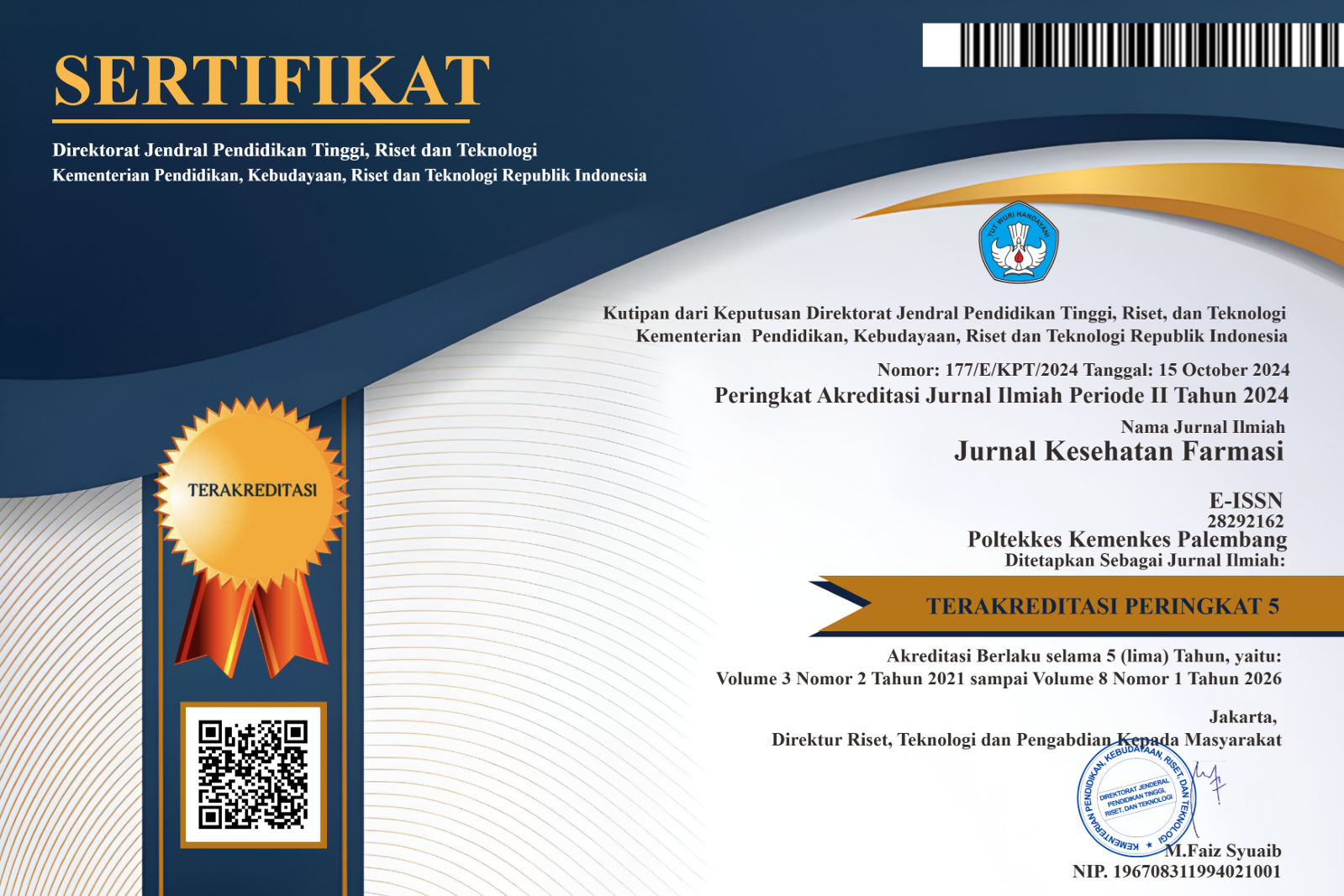Pemeriksaan Rendemen, Kadar Sari Larut Air, dan Kadar Sari Larut Etanol dari Ekstrak Batang Brotowali
Abstract
ABSTRAK
Latar belakang: Brotowali (Tinospora crispa L.) merupakan salah satu tanaman obat yang memiliki berbagai manfaat untuk pengobatan malaria, hepatitis, diabetes mellitus, dan rematik. Brotowali mengandung senyawa kimia antara lain glikosida pikroretosid, palmatin, alkaloid berberin, dan zat pahit pikroretin. Banyaknya manfaat brotowali di kehidupan sehari-hari untuk mencegah dan mengobati berbagai penyakit maka tumbuhan ini berpotensi dikembangkan menjadi sediaan calon obat dalam bentuk ekstrak, sehingga perlu dilakukan standarisasi mutu ekstrak. Diantara parameter mutu ekstrak adalah kadar sari larut air, dan kadar sari larut etanol. Salah satu factor yang mempengaruhi mutu ekstrak adalah ukuran simplisia. Tujuan penelitian ini adalah untuk mengukur pengaruh ukuran simplisia batang brotowali terhadap rendemen, kadar sari larut air, dan kadar sari larut etanol ekstrak.
Metode: Jenis penelitian adalah penelitian eksperimental. Batang brotowali dibagi menjadi dua ukuran yaitu dirajang dan diserbuk, lalu masing-masing dimaserasi dengan etanol 96% dan dikentalkan dengan rotary evaporator. Ekstrak masing-masing dilakukan uji rendemen, kadar sari larut air, dan kadar sari larut etanol.
Hasil: Ekstrak etanol batang brotowali dari simplisia yang dirajang mempunyai rendemen ekstrak sebesar 6,0775%, kadar sari larut air sebesar 27,5950% dan kadar sari larut etanol sebesar 33,3123%. Sedangkan dari simplisia yang diserbuk mempunyai rendemen ekstrak sebesar 10,0918%, kadar sari larut air sebesar 60,7335% dan kadar sari larut etanol sebesar 39,4689%. Ekstrak etanol dari batang brotowali yang diserbuk mempunyai rendemen, kadar sari larut air, dan kadar sari larut etanol yang lebih besar dibandingkan ekstrak etanol dari batang brotowali yang dirajang.
Kata kunci: Rendemen; Kadar sari larut air; Kadar sari larut etanol; Batang brotowali; Ukuran simplisia
Abstract
Background: Brotowali (Tinospora crispa L.) is one of the medicinal plants that has various benefits for treatment. Brotowali contains chemical compounds such as glycosides picroretoside, berberine alkaloids and picroretin bitter substances. With the many benefits of this brotowali to prevent and treat various diseases, this plant has the potential to be developed into a prospective drug preparation in the form of extracts, so it is necessary to standardize the quality of the extract. Among the quality parameters of the extract were the water soluble extract content and the ethanol soluble extract content. One of the factors that affect the quality of the extract is the size of the simplicia. The purpose of this study was to measure the effect of brotowali stem simplicia size on yield, water soluble extract content, and ethanol soluble extract content.
Methods: This type of research is experimental research. Brotowali stems are divided into two sizes, namely chopped and powdered, then each macerated with 96% ethanol and thickened with a rotary evaporator. Each extract was tested for yield, water soluble extract content, and ethanol soluble extract content.
Results: The ethanol extract of brotowali stems from chopped simplicia had an extract yield of 6.0775%, water soluble extract content of 27.5950% and ethanol soluble extract content of 33.3123%. Meanwhile, the powdered simplicia had an extract yield of 10.0918%, water soluble extract content of 60.7335% and ethanol soluble extract content of 39.4689%. The ethanol extract from the powdered brotowali stem had a higher yield, water soluble extract content, and ethanol soluble extract content than the ethanol extract from chopped brotowali stem.
Keywords: Yield; Water soluble extract content; Ethanol soluble extract content; Brotowali stem;Simplicia size
Copyright (c) 2021 JKPharm Jurnal Kesehatan Farmasi

This work is licensed under a Creative Commons Attribution-ShareAlike 4.0 International License.
Authors who publish with this journal agree to the following terms:
- Authors retain copyright and grant the journal right of first publication with the work simultaneously licensed under a Creative Commons Attribution License that allows others to share the work with an acknowledgement of the work's authorship and initial publication in this journal.
- Authors are able to enter into separate, additional contractual arrangements for the non-exclusive distribution of the journal's published version of the work (e.g., post it to an institutional repository or publish it in a book), with an acknowledgement of its initial publication in this journal.
- Authors are permitted and encouraged to post their work online (e.g., in institutional repositories or on their website) prior to and during the submission process, as it can lead to productive exchanges, as well as earlier and greater citation of published work














